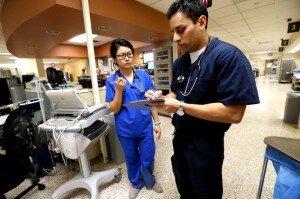The Daily Life of a Certified Medical Assistant
Medical Assistants perform a wide variety of tasks in the healthcare environment. While nurses complete more complex tasks that require more advanced medical training, medical assistants are left to complete more of the “basic” healthcare assignments when caring for patients. Medical Assistants are commonly known to help patients walk to the bathroom when in a facility. A Certified Medical Assistant (CMA) will typically help a patient perform basic hygiene tasks (i.e. showering, going to the bathroom, etc.) especially if a patient is unable to complete these tasks independently.
A CMA is able to other basic tasks such as charting the “intakes and outakes” of the patient (i.e. what they drank, number of bowel movements, etc.), take blood pressure, check additional vitals (i.e. respiration rate, heart rate, oxygen levels, etc.).
Comparing Tasks of a Medical Assistant to a Registered Nurse
An outsider to the healthcare environment may wonder what a nurse is doing while if a CMA is performing the tasks described mentioned above. Registered nurses will be fulfilling orders requested by physicians. Nurses retrieve medications and administer them to patients – especially in the nursing home environment. While the work of a Certified Medical Assistant may seem unappealing to some considering going into the field, the role of this worker cannot be underestimated.
Without CMAs, nurses would be more overworked then they already are. The role of being a Certified Medical Assistant is an excellent position for someone who is thinking of going into healthcare and is considering being a nurse, nurse practitioner, physician, or physician assistant. Certified Medical Assistants work in a variety of environments, witness many different situations, and gain direct experience by watching healthcare providers care for a diverse variety of patients.
Variety of Healthcare Environments
Certified Medical Assistants work in a variety of healthcare environments- from the hospital to nursing homes to surgical offices to urgent cares. Depending on the healthcare environment and where a CMA is working, a CMA’s tasks will vary greatly. Emergency Room Medical Assistants are more apt to complete the necessary paperwork, necessary phone calls, paging, and organizational work for physicians and other providers. These particular medical assistants may do minimal basic care such as providing blankets and fetching drinks, and food for patients, but nothing more complicated than to that extent.
In a nutshell, ER Medical Assistants’ role can be described as “clerical.” Some nurses and physicians will even go as far to say that these workers “run the ER.” In this sense, this phrase means that if a Medical Assistant were to walk out of an Emergency Room, the process and flow of an ER would fall apart. Most hospitals contain a unit called a Medical-Surgical unit. Patients that are sick, recovering from surgery, and or need to be hospitalized for medical reasons remain in this part of the hospital. These patients typically need to be watched, but are not as critical as some of the patients that enter the Emergency Room.
 There are more apt to be more Medical Assistants in this type of environment, because of the great need for basic care. Medical Assistants would help keep track of vitals of patients and alert nurses if any vitals seems abnormal. This environment is similar to a nursing home, but a nursing home would be less likely to have as critical patients. Hospitals typically contain a unit that is entitled “Intensive Care.” This unit is a very special unit in that most patients that are admitted to this part of the hospital require one-on-one care and great concentration.
There are more apt to be more Medical Assistants in this type of environment, because of the great need for basic care. Medical Assistants would help keep track of vitals of patients and alert nurses if any vitals seems abnormal. This environment is similar to a nursing home, but a nursing home would be less likely to have as critical patients. Hospitals typically contain a unit that is entitled “Intensive Care.” This unit is a very special unit in that most patients that are admitted to this part of the hospital require one-on-one care and great concentration.
Similar in the nature to the emergency room, Medical Assistants are not needed as much in this environment, but can still perform basic tasks such as taking vitals, answer phone calls, complete phone calls, and assist with transporting patients (i.e. to Radiology, etc.). This is another great setting that Medical Assistants can shadow in on and discover if advancing in the medical field is something they are interested in.
The final setting that Medical Assistants are able to work in is that of a medical office; the opportunities are endless in this realm – from doctor’s offices, surgical offices, an urgent care, a physical therapist office, orthodontist’s office. The very positive note about being a Certified Medical Assistant is that many offices prefer to hire CMA’s as opposed to someone who may just have an Associate’s degree in Business.
Medical Assistants in an office setting may help prep exams and materials in patient’s rooms, perform basic vitals and tasks for patients, greet patients upon arrival, complete insurance coding processes, and schedule appointments.
Benefits of Being a Certified Medical Assistant
The decision to become a Certified Medical Assistant can be a daunting decision to make – especially if a person has not spent a lot of time in the healthcare environment. Pondering Certified Medical Assistants are encouraged to volunteer in healthcare settings and get an idea of how they enjoy the experience. Applicants may be afraid of some of the tasks that are considered to be “dirty” or hard work, but there is something to be said for the work ethic, passion, and compassion Certified Medical Assistants bring with them every day to work when ensuring that patients are safe and cared for.
Certified Medical Assistants are able to obtain an Associate’s Degree, save money before moving right on to an Bachelor’s degree, and allow themselves some workforce experience to discover more about themselves and their career goals and desires. An aspiring nurse may decide to become a physical therapist after working in a variety of healthcare environments and taking the time to note their thoughts and interests. Becoming a Certified Medical Assistant provides an ample array of diverse healthcare environments where a variety of tasks are sure to keep an individual growing and learning everyday on the job
More related articles
Comments
comments









